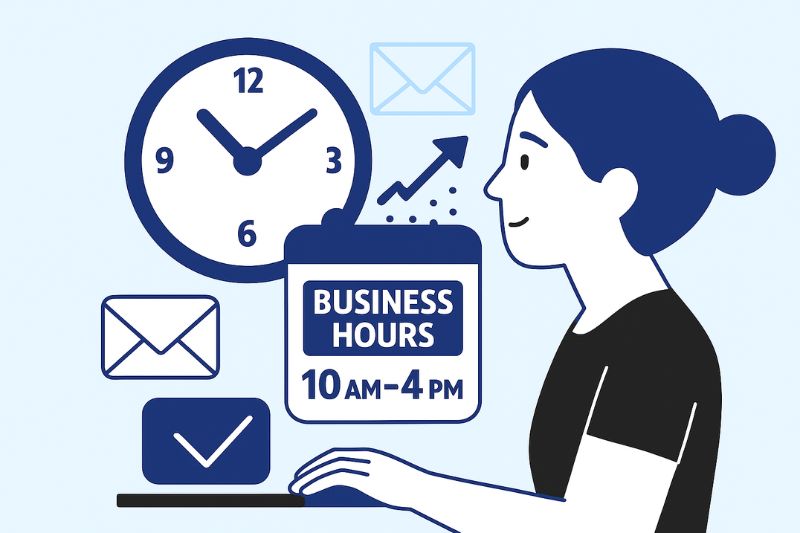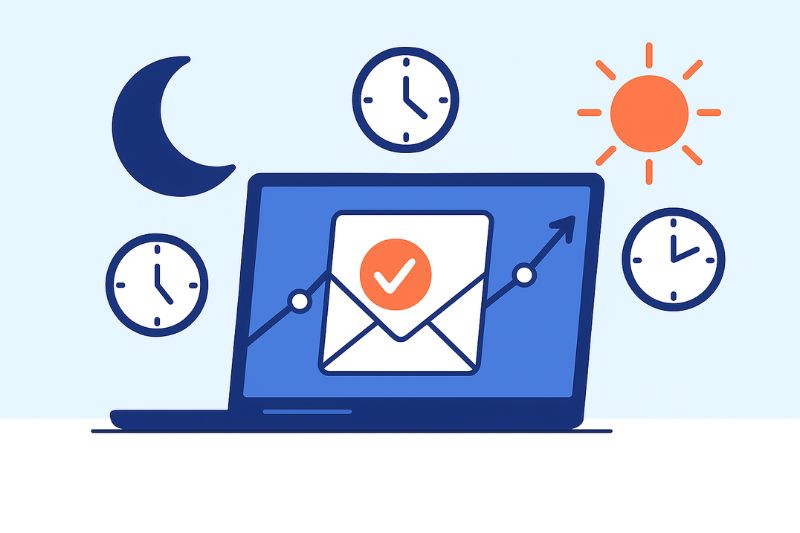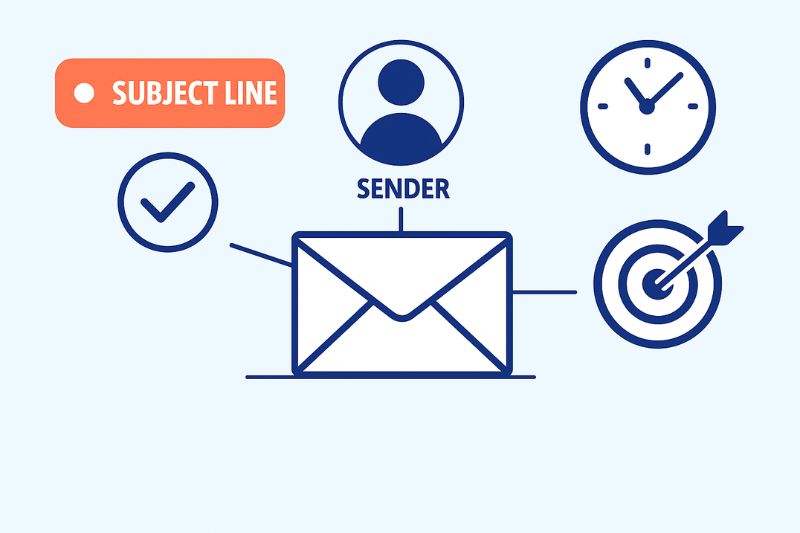About the author:
Darren Blumenfeld is the CEO and Founder of InboxAlly, an email deliverability platform trusted by growth-focused marketers. He’s previously founded HonestMail, worked at NASA, and holds degrees from Tufts and Columbia. His passion for tech, education, and creativity continues to inspire innovation in email outreach.
You’re putting in the work: crafting cold marketing emails, personalizing your outreach, and targeting the right prospects. But if no one opens or replies, what’s the point?
The truth is, timing can make or break your campaign. Even the best-written cold email is easy to miss if it lands in a cluttered inbox at the wrong moment.
In this article, we’ll break down the best times and days to send cold emails based on recent data, reveal the worst times to avoid, and share tips that can help you improve open and reply rates, so your messages land when your prospects are most likely to take action.
Key Takeaway:
The best time to send a cold email is Tuesday to Thursday between 10 AM and 2 PM, in your recipient’s local time zone. These midweek, mid-morning hours consistently show the highest open and reply rates. Avoid evenings, weekends, and holidays when engagement tends to drop sharply.
Why Timing Matters for Cold Email Outreach
Even the most personalized cold email can fall flat if it reaches someone at the wrong moment.
In today’s crowded inboxes, timing is one of the biggest variables that affects open and response rates. If your email isn’t seen within the first few hours, there’s a high chance it will never be opened at all.
Studies show that recipients are more likely to ignore or delete emails that arrive outside of standard business hours or at times of peak workload.. And because most people read only a small fraction of the emails they receive each day, hitting the inbox at the right time is your best chance to stand out.
For cold outreach especially, you only get one shot at the first impression. That’s why understanding when to send cold emails, based on behavioral patterns, time zones, and research-backed data, is essential if you want replies, not just sends.
Best Days of the Week to Send Cold Emails
![]()
Tuesdays, Wednesdays, Thursdays
According to a study from Omnisend, the best days to send cold emails are Tuesday, Wednesday, and Thursday. These midweek days consistently outperform Mondays and Fridays when it comes to open and reply rates.
Why? Early in the work week, many professionals are catching up on tasks from the weekend. By Tuesday, they’ve settled into their routine and are more likely to engage with new messages.
Wednesday and Thursday continue this trend as recipients stay active and responsive without the distraction of weekend planning.
Best Times of Day to Send Cold Emails
Aim to send emails early in the morning (6–9 AM) and mid-morning (around 11 AM), in the recipient’s local time.
Early Morning (6–9 AM)
A 2025 study analyzing over 85,000 personalized outreach emails found that sending between 6–9 AM PST (9 AM–12 PM EST) delivered the highest open and click rates for cold emails, outperforming afternoon slots.
Why It Works
- Less competition early: Email volume is lower first thing in the morning, giving your email more visibility in the inbox.
- Attention before the rush: Recipients who check their inbox first thing are more likely to engage before their workday ramps up.
When Are Cold Emails Most Likely to Get Replies?
Cold emails are most likely to receive replies during mid-morning (9–11 AM) and mid-afternoon (1–3 PM), in the recipient’s local time zone.
Recent studies suggest that reply behavior doesn’t always mirror open rates. While emails might be opened early in the morning, many recipients delay responding until they’ve cleared urgent tasks and have more time to write a thoughtful reply.
Key Findings:
- Yesware (2023) analyzed over 25 million emails and found that replies peaked mid-morning (10 AM) and again just after lunch (1–2 PM).
- HubSpot data supports this pattern, showing reply rates are highest between 9 AM and 11 AM, then again around 2 PM, particularly for B2B sales outreach efforts.
- A smaller study from SalesHandy observed an unexpected reply spike around 4 PM, possibly tied to end-of-day inbox reviews.
Times to Avoid When Sending Cold Emails
Do not send cold outreach campaigns during evenings, weekends, holidays, and lunch hours, as engagement drops sharply during these times.
- Evenings (After 5 PM)
Most people are offline, distracted, or prioritizing personal time. Emails sent in the evening tend to get buried by the next morning’s influx and rarely resurface.
- Weekends
Unless you’re emailing a highly niche segment known to work weekends, avoid Saturdays and Sundays. Research from Omnisend and Mailchimp shows that weekend emails consistently underperform in both open and reply rates.
- Lunch Hours (12–1 PM)
Midday is not the best time for email outreach. Recipients are either away from their desks or not in a decision-making mindset. Emails sent during lunch tend to be skimmed or ignored.
- Holidays and Mondays
Mondays can be hit or miss. Some professionals check their inbox early, but many are swamped catching up. Emails are often buried under a pile of other messages, reducing the chance of being seen. National holidays are also poor performers due to reduced screen time and overflowing inboxes the next day.
Factors That Affect Cold Email Open Rates
Each of these factors adds to the overall performance of your cold email campaign, and none is more important than the others. Below, we’ll break them down and share valuable insights into how they work and why they matter.
1. Subject Line
Your subject line is the first, and sometimes only, chance to grab attention.
- Keep it short (under 50 characters)
- Avoid clickbait
- Personalize when possible
- A/B test different tones (e.g., curiosity vs. clarity)
Important stat: 47% of recipients open an email based on the subject line alone (OptinMonster, 2023).
2. Sender Name and Address
Recipients are more likely to open emails from a real person than a generic or automated address.
- Use a recognizable name and photo if possible
- Avoid “no-reply@” or “sales@” formats
- Make sure your domain has proper authentication (SPF, DKIM, DMARC)
3. Relevance to the Recipient
Cold emails that feel irrelevant are ignored, or worse, marked as spam.
- Segment your target audience by job role, company size, or pain points
- Reference specific challenges, tools, or goals in your message
4. List Quality
No amount of personalization can save a bad list.
- Use verified, up-to-date contact data
- Clean your list regularly to remove bounces or disengaged leads
- Avoid purchased lists, as they often reduce deliverability
Conclusion
Sending cold emails at the right time is just one part of the equation, but it’s a critical one. With crowded inboxes and shrinking attention spans, the difference between being read and being ignored often comes down to when your message lands.
To improve your cold email performance:
- Send on Tuesdays through Thursdays, ideally between 6–11 AM local time
- Avoid evenings, weekends, and holidays
- Segment your list and personalize each message
- Focus on subject lines, deliverability, and reply tracking
Most importantly, test and adapt. The best timing for one audience might not work for another. Use tools like InboxAlly to monitor deliverability, track engagement patterns, and continuously optimize your sending strategy.
Want better results from your cold outreach? Book a demo with InboxAlly and see how better timing and deliverability can transform your email campaigns.



